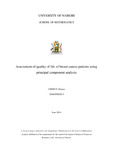| dc.description.abstract | Background: The most commonly diagnosed cancers worldwide are those of the lung, breast
and colorectum. Breast cancer is the most common cancer in women worldwide. In 2012,
1.7 million women were diagnosed with breast cancer and there were 6.3 million women
alive who had been diagnosed with breast cancer in the previous five years. Since 2008,
breast cancer incidence has increased by more than 20%, while mortality has increased by
14%. A cross-sectional study was carried out at the Haemato-oncology and Cancer Treatment
Centre of Kenyatta National Hospital to assess the quality of life (QOL) of breast cancer
patients. Patients receiving cancer treatment were consecutively recruited at a rate of 20
patients per week until the required sample size of 140 was achieved. Each patient was
interviewed using a validated tool for assessing quality of life in cancer patients – European
Organization for Research and Treatment of Cancer, Quality of Life Questionnaire (EORTC
QLQ-C30). Principal component analysis (PCA) was used to identify a single variable that
indicates QOL, before applying logistic regression to assess the predictors of QOL. Nonlinear
PCA analysis resulted in total percentage variance accounted for (PVAF) of 46.8%. The
median QOL score was 2.45. The mean age of the respondents was 49.4 ±10.2 years. 61.8%
of the respondents were in their late stages of the disease. Thirty eight percent respondents
were on chemotherapy, 27.5% on radiotherapy, 20.4% on tamoxifen and 14.1% were on
surgery. The study found out that surgery (p=0.010) and tamoxifen treatments (p=0.001) are
statistically significant predictors. Ages, marital status, education, parity, stage of the disease
and radiotherapy treatment are not significant predictors. The study concludes that breast
cancer patients have poor quality of life, and those in the late stage of the disease are more
likely to have poor quality of life compared to those in the early stage. Patients receiving
surgery and taxomifen reported lower QOL score. This study will therefore be used in
management of QOL of breast cancer patients by directing innovative interventions that improve
quality of life of patients.
Key words: Breast cancer, PCA, QLQ-C30, EORTC, PVAF | en_US |


